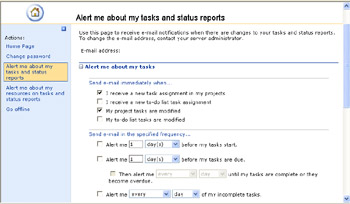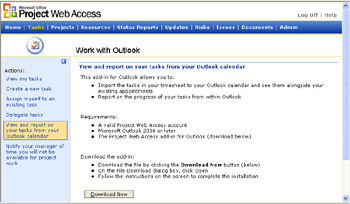Setting Up E-Mail Reminders and Calendars
Through Project Web Access, you have some tools at your disposal for making your life a little easier. You can set up automated notifications so you can receive e-mail reminding you about various aspects of your project and progress tracking. You can also integrate your project tasks into your Microsoft Office Outlook 2003 calendar.
Configuring E-Mail Notifications
To configure automated e-mail reminders to yourself, follow these steps:
-
In the Project Web Access navigation bar, click Home.
-
In the side pane of your Home page, click Alert Me About My Tasks And Status Reports .
The Alert Me page appears (see Figure 23-15).

Figure 23-15: Specify any e-mail notifications you want to receive. -
Review the options throughout this page, and select the check boxes for the events for which you want to be notified via e-mail. Clear the check boxes for events for which you do not want an e-mail notification.
You can set up e-mail notification options for upcoming tasks, overdue tasks, and for status reports.
-
When finished, click Save Changes at the bottom of the page.
Working with Project Tasks in Your Outlook Calendar
New Feature If you use Microsoft Outlook, you can keep track of your assigned tasks in your Outlook Calendar , along with your other appointments. You can update progress on your project assignments in the Calendar and report the status back to Project Server directly from Outlook.
Project tasks can be displayed as free or busy time, just like any other Calendar entries.
| Note | Outlook integration with Project Web Access allows integration with the Outlook Calendar, but not with Outlook Tasks. |
If you choose to integrate your project assignments with your Outlook Calendar like this, your assignments are still published from Project Professional to the project server. At that point, your assignments appear in your Outlook Calendar as well as in your Project Web Access Tasks list. You still use Project Web Access for the custom fields, project views, status reports, and other project- related features. However, you now have a choice to work in Project Web Access or Outlook to review, track, and update your project assignments.
From the Outlook Calendar, you can update your assignments and send actual progress information back to the project manager via the project server. As usual, the project manager reviews and approves your updates and incorporates them into the project plan.
Setting Up Outlook Calendar Integration
To set up Project Web Access integration with Outlook, follow these steps:
-
In the Project Web Access navigation bar, click Tasks.
-
In the side pane of the Tasks page, click View And Report On Your Tasks From Your Outlook Calendar.
The Work With Outlook page appears (see Figure 23-16).

Figure 23-16: Go to the Work With Outlook page to download the Outlook Integration add-in. -
Review the information about the Outlook Integration add-in.
-
Click Download Now.
The COM add-in is installed.
To establish the connection between Outlook and Project Web Access, follow these steps:
-
In Outlook, click Tools, Options.
-
In the Options dialog box, click the new Microsoft Project Web Access tab.
-
Click the Enter Login Information button.
-
In the Microsoft Project Server URL box, enter the address to your project server, for example, http:// servername /projectserver .
If you click the Test Connection button, Outlook tests the URL you entered and makes sure that it's a valid project server.
-
Under When Connecting, specify whether you should be validated with your Windows user account or whether you're using a separate Project Server account name .
Importing Project Assignments into the Outlook Calendar
To import assignments from Project Web Access into your Outlook Calendar, follow these steps:
-
In Outlook, click Tools, Options and then click the Microsoft Project Web Access tab.
-
Under Date Range, specify the time period from which you want assignments to be imported.
If you want to import assignments from the standard reporting time period set up in Project Web Access, select the Microsoft Project Server Date Range option.
If you want to import assignments from a different time period (for example, the next2weeks), select the Next option and then select the date range.
-
In the Show Availability For Project Assignment Appointment, specify your availability for other appointments during the time of your assignments.
Just as with other Outlook appointments, you can show your availability as free, busy, tentative, or out of the office. This setting becomes the default for all project assignments in the Outlook Calendar. You can still change the availability for individual assignments as needed.
-
Under Import From Microsoft Project Web Access To Your Outlook Calendar, specify whether you want assignments to be imported manually or automatically.
Select the Manually option if you want to import assignments yourself.
Select the Every option if you want to import assignments automatically on a time schedule that you set in the associated boxes.
To import Project Web Access assignments manually, follow these steps:
-
Open the Outlook Calendar view.
-
Show the Project Web Access toolbar by clicking View, Toolbars, Project Web Access.

-
On the Project Web Access toolbar, click Import New Assignments.
The Import Assignments From Project Web Access dialog box appears, listing project assignments within the date range set in the Options dialog box.
If you never need to see this dialog box, select the Don't Show The Dialog In The Future, Just Import check box.
-
Click OK.
The listed assignments are imported into your Outlook Calendar.
Updating Assignments in the Outlook Calendar
To set up how you want to update assignment progress information from the Outlook Calendar to Project Web Access and Project Server, follow these steps:
-
In Outlook, click Tools, Options and then click the Microsoft Project Web Access tab.
-
Under Assignment Update, specify whether you want assignment updates to be sent manually or automatically.
Select the Manually option if you want to send assignment updates only upon your explicit command.
Select the Every option if you want to update assignment progress automatically at regular time periods that you set in the associated boxes.
To record progress on a project assignment from Outlook, follow these steps:
-
Open the Outlook Calendar view.
-
Double-click the assignment for which you want to record progress.
The appointment form appears, showing assignment details. In addition to the normal Appointment and Scheduling tabs, the Project Web Access tab is added.
-
Click the Project Web Access tab.
This tab shows your timesheet as it looks in Project Web Access, so you can update progress information.
-
Depending on the tracking method configured for your project, enter the hours worked per time period, percent complete, or actual work and remaining work.
-
To send the updated information to Project Server, click the Update Project Manager button.
To save the changes for an update at a later time, click the Save Changes button. Click Save Changes if you have other assignments to update and you want to send all updates at once, or if you chose the automated update option and Outlook will be sending all updates at that scheduled time.
To update assignment progress to Project Server manually, follow these steps:
-
Open the Outlook Calendar view.
-
Make sure that the Project Web Access toolbar is displayed.
If it is not, click View, Toolbars, Project Web Access.

-
On the Project Web Access toolbar, click Update Project Web Access.
The dialog box lists all project assignments. In the Update column, select the check boxes of the assignments you want to update.
EAN: 2147483647
Pages: 268